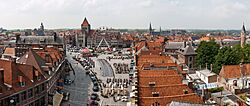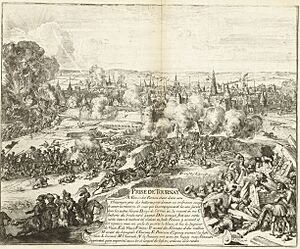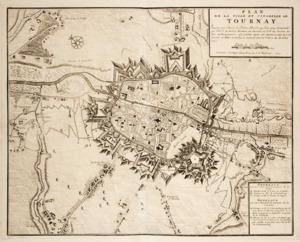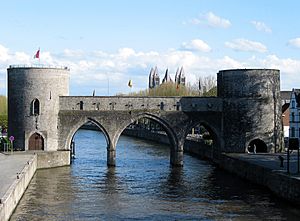Tournai facts for kids
Quick facts for kids
Tournai
Tornai (Picard)
Doornik (Dutch)
|
|||
|---|---|---|---|

Grand-Place of Tournai
|
|||
|
|||
| Country | Belgium | ||
| Community | French Community | ||
| Region | Wallonia | ||
| Province | Hainaut | ||
| Arrondissement | Tournai | ||
| Area | |||
| • Total | 213.75 km2 (82.53 sq mi) | ||
| Population
(2018-01-01)Lua error in Module:Wd at line 1575: attempt to index field 'wikibase' (a nil value).
|
|||
| • Total | Lua error in Module:Wd at line 1,575: attempt to index field 'wikibase' (a nil value). | ||
| Postal codes |
7500-7548
|
||
| Area codes | 069 | ||
Tournai is an old and important city in Wallonia, Belgium. It is located in the Province of Hainaut, in the southwest part of the country. The city sits on the Scheldt river, about 89 kilometers (55 miles) southwest of Brussels.
Tournai is known as one of Belgium's oldest cities. It has played a big part in the country's history and culture. It was even the first capital of the Frankish Empire, and Clovis I, a famous king, was born here. In 2022, about 68,518 people lived in Tournai.
Contents
Exploring Tournai's Location
Tournai is found in the southwest of Belgium. It is part of the Province of Hainaut in the Wallonia region. The city is built along the Scheldt river. The total area of Tournai and its surrounding villages is about 213.75 square kilometers (82.53 square miles).
Villages and Towns in Tournai
The municipality of Tournai includes many smaller places. These are:
- Barry
- Beclers
- Blandain
- Chercq
- Ere
- Esplechin
- Froidmont
- Froyennes
- Gaurain-Ramecroix
- Havinnes
- Hertain
- Kain
- Lamain
- Marquain
- Maulde
- Melles
- Mont-Saint-Aubert
- Mourcourt
- Orcq
- Quartes
- Ramegnies-Chin
- Rumillies
- Saint-Maur
- Templeuve
- Thimougies
- Tournai (the main city)
- Vaulx
- Vezon
- Warchin
- Willemeau
Tournai's Long History
Tournai, once called Tornacum, was a small but important stop in Roman times. It was where a Roman road crossed the Scheldt river. In the 3rd century AD, it became a fortified town.
Early Frankish Capital
In 432, the Salian Franks took control of Tournai. It became the capital of the Frankish Empire under Childeric I. His tomb was found here in 1653. Later, in 486, Clovis I moved the main power center to Paris. A local man, Eleutherius, became the first bishop of Tournai. In 862, Charles the Bald made Tournai the main city of the County of Flanders.
Growth and Independence
After the Frankish Empire split, Tournai stayed with the western part, which became France in 987. In the 11th century, Tournai grew into a busy town. It became famous for making wool cloth using English wool. A big project to rebuild the cathedral started in 1030.
The city gained its independence from local counts in 1187. From then on, it was directly under the French king. The famous stone bridge, Pont des Trous (Bridge of the Holes) , was built over the Scheldt river in 1290.
Wars and Changes in Rule
In 1340, during the Hundred Years' War, Edward III of England tried to capture Tournai. He besieged the city for a month, but he failed. This made him run out of money and sign a peace treaty.
During the 1400s, Tournai's textile business boomed. It became a major producer of beautiful tapestries. Painting also thrived, with artists like Jacques Daret, Robert Campin, and Rogier van der Weyden coming from Tournai.
In 1513, Henry VIII of England captured Tournai. This made it the only Belgian city ever ruled by England. It was given back to France in 1519.
In 1521, Holy Roman Emperor Charles V took control of Tournai. This led to a difficult time with religious conflicts and less trade. Tournai was a center for Calvinism. However, in 1581, the Spanish governor, the Duke of Parma, captured the city after a long siege. Protestants living there were allowed to leave within a year, which was seen as fair at the time.
A century later, in 1668, Tournai briefly returned to France under King Louis XIV. The city was besieged again in 1709 by the Duke of Marlborough during the War of Spanish Succession. After this war, in 1713, Tournai became part of the Austrian Netherlands. France besieged the city again in 1745.
In 1794, France took over the Austrian Netherlands during the French Revolutionary Wars. Tournai became part of a French department. After the Napoleonic Wars in 1815, Tournai joined the United Netherlands. Then, in 1830, it became part of the new country of Belgium. Tournai was badly damaged in 1940 during World War II but has been carefully rebuilt since then.
Amazing Sights in Tournai
Tournai is considered one of Belgium's most important cultural places. The Cathedral of Our Lady is a mix of Romanesque and Gothic styles. The city's Belfry is thought to be the oldest in Belgium. Both of these are so special that UNESCO has named them World Heritage Sites. Inside the cathedral, you can see the Châsse de Notre-Dame flamande, a beautiful 12th-century reliquary. It shows how wealthy Tournai was in the Middle Ages.
Other interesting places include the 13th-century Scheldt bridge (Pont des Trous) and the main square, called the Grand-Place. You can also find old city gates, historic warehouses, and many museums. Like in many Belgian cities, the Grand-Place has several cafés and pubs. In the middle of the square, there are fountains. You can also climb a circular staircase to the top of the Belfry for great views.
On Rue Barre-St-Brice, you can see two of Europe's oldest private houses. They were built between 1175 and 1200 in the Romanesque style. Rue des Jésuites has a Gothic house from the 13th century. There are also many buildings in the Art Nouveau style around the city.
Tournai's Culture
A French-Speaking Walloon Town
Tournai is a French-speaking city in Belgium. The local way of speaking is called tournaisien, which is a Picard dialect. This dialect is similar to those spoken in other parts of Hainaut and Northern France. Tournai is also part of "Romance Flanders," like cities such as Lille and Mouscron. The city was once a very important cultural and economic center of the County of Flanders. You can still see signs of this today:
- The Gothic choir of Our Lady's Cathedral was an early example of the Scaldian (from the Scheldt area) Gothic art, which is typical of Flanders.
- The Bishopric of Tournai was the religious capital of Flanders for over a thousand years (from 496 to 1559).
- Tournai's tapestries and fabrics were part of the famous Flemish school of tapestry. Tournai was also part of the Flemish Hansa of London, a group of trading towns.
- The Church of St. Brice is one of the first examples of the hallekerk style, which is very common in the Flemish countryside.
- The Church of St. Quentin is a Catholic church in Romanesque style with Gothic parts. It has existed since the 10th century. The current building was built around 1200. It holds important sculptures by the 15th-century artist Jean Delemer.
- Some of the greatest Flemish Primitives (early Flemish painters) came from Tournai. These include Robert Campin, Rogier van der Weyden, and Jacques Daret.
Even though Tournai is in the Flemish cultural area, it also has some beautiful examples of the Mosan style. The two most beautiful shrines in the cathedral were made in the Liège region by the artist Nicholas of Verdun. These are the shrines of Saint-Eleutherius and Our Lady of Flanders (from the 13th century). These shrines show how rich Tournai and Liège were in the Middle Ages. The shrine of Our Lady of Flanders is even called one of the seven wonders of Belgium.
Fun Festivities
- The "Great Procession" (in French: Grande Procession) is a parade that started in 1092. It was begun by Bishop Radbot II during a plague epidemic. It has happened every year since then, except for one year in 1566. This historic parade takes place in the streets every second Sunday of September.
- The first Monday after January 6 is called "Lost Monday" (in French: Lundi perdu). This tradition is more than 700 years old. Richer families used to prepare big dinners and choose a "king." Today, these dinners are for larger groups, and a rabbit dish is often served.
Learning in Tournai
The Faculty of Architecture, Architectural Engineering and Urban Planning of the French-speaking University of Louvain (UCLouvain) is located in Tournai.
Famous People from Tournai
Many notable people were born in Tournai, including:
- Clovis I, the first king of all the Salian Franks (5th century)
- Gilles Li Muisis, a French writer and poet (13th century)
- Rogier van der Weyden, a famous Flemish painter (15th century)
- Jacques Daret, another Flemish painter (15th century)
- Pierre de La Rue, a Franco-Flemish composer (15th century)
- Perkin Warbeck, an impostor who claimed to be the king of England (15th century)
- Marbrianus de Orto, a Franco-Flemish composer (15th-16th century)
- Charles Blount, 5th Baron Mountjoy, a courtier and supporter of learning (16th century)
- Isaac Le Maire, an important merchant of the Dutch East India Company (16th century)
- Louise-Françoise de Bourbon (1673–1743), an illegitimate daughter of Louis XIV of France
- Peter Minuit, known for buying Manhattan Island for the Dutch
- Donat Casterman, a publisher (18th century)
- Philippe de la Motte, a pastor (16th-17th century)
- Piat Sauvage, a painter (19th century)
- Louis Gallait, a painter (19th century)
- Jean-Baptiste Moëns, a stamp collector (19th century)
- Jules Bara, a statesman (19th century)
- Georges Rodenbach, a Symbolist poet and writer (19th century)
- Hélène Dutrieu, a cycle racer, stunt driver, and aviator (19th and 20th centuries)
- Marc Quaghebeur, a writer (20th century)
- Xaveer De Geyter, an architect (20th century)
- Gabrielle Petit, a spy for the British Secret Service during First World War (20th century)
- Viviane Nicaise, a cartoonist and colorist (21st century)
Image gallery
Twin Towns
Tournai is twinned with these cities:
 Troyes, France
Troyes, France Villeneuve-d'Ascq, France
Villeneuve-d'Ascq, France Bethlehem, Palestine
Bethlehem, Palestine Tarija, Bolivia
Tarija, Bolivia
See also
 In Spanish: Tournai para niños
In Spanish: Tournai para niños














